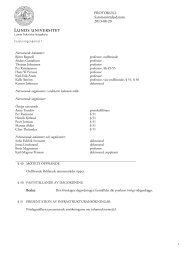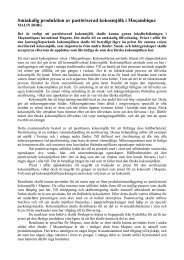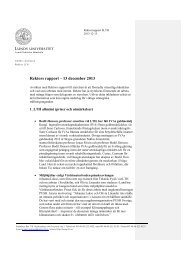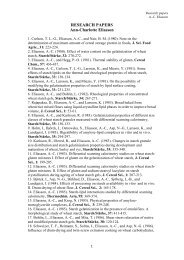User Experience Design at Sony Ericsson - Introducing the Virtual Pet
User Experience Design at Sony Ericsson - Introducing the Virtual Pet
User Experience Design at Sony Ericsson - Introducing the Virtual Pet
You also want an ePaper? Increase the reach of your titles
YUMPU automatically turns print PDFs into web optimized ePapers that Google loves.
Why Should <strong>Sony</strong> <strong>Ericsson</strong> Consider Developing a <strong>Virtual</strong> <strong>Pet</strong>?<br />
Current Use of <strong>Virtual</strong> <strong>Pet</strong>-like Technologies<br />
- Background Pictures and Screensavers<br />
Though <strong>the</strong>y are not quite as complic<strong>at</strong>ed as virtual pets, users are<br />
currently personalizing <strong>the</strong>ir phones with background pictures and<br />
screensavers. These are very simple, black and white pictures or short<br />
anim<strong>at</strong>ions; never<strong>the</strong>less, users seem to be willing to pay a small fee to<br />
decor<strong>at</strong>e <strong>the</strong>ir phone. Looking <strong>at</strong> wh<strong>at</strong> c<strong>at</strong>egories of pictures th<strong>at</strong> are most<br />
popular, it could be noticed th<strong>at</strong> animals and cartoon characters seem to<br />
domin<strong>at</strong>e, trailed by love messages, p<strong>at</strong>terns and corpor<strong>at</strong>e logos. The<br />
emphasis on wh<strong>at</strong> could be considered “st<strong>at</strong>ic pets” may suggest th<strong>at</strong><br />
users would be willing to pay for a slightly more advanced pet to look <strong>at</strong>,<br />
play with or take care of.<br />
- Tamagotchi and O<strong>the</strong>r Toys<br />
As noticed above, <strong>the</strong> massive success of Tamagotchi, and l<strong>at</strong>er on <strong>the</strong><br />
Pokemon characters, might imply th<strong>at</strong> <strong>the</strong>re is already a r<strong>at</strong>her widespread<br />
acceptance of virtual pets. Though <strong>the</strong> phenomenon was originally born<br />
in Japan, it is not limited to its initial market. Furby from Tiger Toys –<br />
best described as a crossover between a virtual pet and a cuddling toy -<br />
was <strong>the</strong> no 1 selling toy in <strong>the</strong> UK in 1998 and 1999, where it was also<br />
crowned Toy of The Year in 1999 (www.furby.co.uk).<br />
- Computer Software<br />
There are numerous of software titles th<strong>at</strong> explore <strong>the</strong> virtual pet<br />
concept. Post<strong>Pet</strong>, conceived by <strong>the</strong> artist Kazuhiko Hachiya and<br />
co developed with <strong>Sony</strong> Communic<strong>at</strong>ion Network Corpor<strong>at</strong>ion,<br />
in 1999 became <strong>the</strong> most popular e-mail software among <strong>the</strong><br />
Japanese youth (Kusahara 2000). Post<strong>Pet</strong> users can choose<br />
between several pets with different personalities th<strong>at</strong> live in<br />
a virtual apartment.<br />
The pets act as <strong>the</strong>ir personal postman, delivering e-mail to<br />
o<strong>the</strong>r Post<strong>Pet</strong> users by traveling to <strong>the</strong> o<strong>the</strong>r recipient’s house.<br />
Here <strong>the</strong> user’s pet delivers <strong>the</strong> mail and may also play around<br />
with <strong>the</strong> o<strong>the</strong>r pet if it is in, or play by itself a while if <strong>the</strong>re is no<br />
<strong>Sony</strong>’s e-mail program Post<strong>Pet</strong>.<br />
one home.<br />
SereneScreen Marine Aquarium is a beautiful virtual aquarium screensaver. Though it lacks interaction ability, it<br />
has during periods been <strong>the</strong> number one downloaded screensaver on <strong>the</strong> Internet (www.serenescreen.com)<br />
acknowledging th<strong>at</strong> users sometimes want pets simply to look <strong>at</strong> for fun or relax<strong>at</strong>ion.<br />
Recent Research on <strong>User</strong> Behavior<br />
- Acceptance of Medi<strong>at</strong>ed Characters<br />
Most downloaded picture messages<br />
and logos from www.lunarstorm.se<br />
Reeves and Nass (1996) have argued th<strong>at</strong> media equals real life. Humans tend to tre<strong>at</strong> media as real social actors,<br />
interpreting signals as though <strong>the</strong>y were given by a real person. People tend to be polite to computers and also<br />
accept digital fl<strong>at</strong>tery and respond to it positively. Lombard and Ditton (1997) refer to this illogical tre<strong>at</strong>ment of<br />
medi<strong>at</strong>ed entities as social actors as <strong>the</strong> illusion of nonmedit<strong>at</strong>ion. Kusahara (2000) notices <strong>the</strong> same phenomenon and<br />
calls it cre<strong>at</strong>ion of subjective reality, arguing th<strong>at</strong> it is <strong>the</strong> psychological reason for why people accept virtual pets like<br />
<strong>the</strong> Tamagotchi.<br />
Though <strong>the</strong>re are some concerns whe<strong>the</strong>r <strong>the</strong> Media Equ<strong>at</strong>ion holds true for mobile terminals as well (Goldstein<br />
et al 2002), <strong>the</strong> equ<strong>at</strong>ion indic<strong>at</strong>es th<strong>at</strong> people may accept a virtual pet as a near real cre<strong>at</strong>ure, <strong>the</strong>reby making it<br />
possible for a virtual pet to elicit real, positive feelings in users. Fogg and Nass (1997) conclude th<strong>at</strong> adding<br />
fl<strong>at</strong>tery can significantly enrich human-computer interaction.<br />
7

















